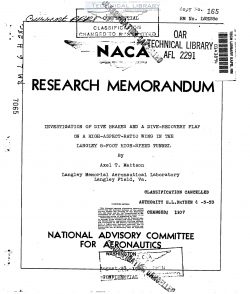naca-rm-l6h28c
- Version
- 200 Downloads
- 3.71 MB File Size
- 1 File Count
- March 14, 2017 Create Date
- March 14, 2017 Last Updated
National Advisory Committee for Aeronautics, Research Memorandum - Investigation of Dive Brakes and a Dive Recovery Flap on a High Aspect Ratio Wing

The results of tests made to determine the aero—
dynamic characteristics of_a solid brake, a slotted brake,
and a dive—recovery flap mounted on a high—aspect-ratio
wing at high Mach numbers are presented. The data were
Obtained in the Langley 8—foot high—speed tunnel for cor-
rected Mach numbers up to 059h0. The results have been
analyzed with regard to the suitability of dive-control
devices for a proposed high-speed airplane in limiting
the airplane terminal Mach number by the use of dive
brakes and in achieving favorable dive-recovery charac—
teristics by the use of a dive—recovery flap. The
analysis of the results indicated that the slotted brake
would limit the pro osed airplane terminal Mach number
to values below 0.850 for altitudes up to 55,000 feet
and a wing loading of 80 pounds per square foot and the
dive-recovery flap would produce trim changes required
for controlled pull—outs at 25,000 feet for a Mach number
range from 0.800 to 0.900. Basic changes in spanwise
loading are presented to aid in the evaluation of the
wing strength requirements.
The investigation presented was undertaken because
of the adverse compressibility phenomena that affect the
longitudinal stability and control of high-speed airplanes
a and because of the vital eed for safety in dives at high
Mach numbers. The inveigg tion was conducted in the
Langley 8—foot high—speed in order to obtain data
for use in evaluating the ae égkpimic characteristics of
dive—control devices at high malt? ‘ers. The aerody-
namic characteristics of a low-drag equipped with a
solid brake, a slotted brake, and a dive—recovery flap
for application as dive-control devices are presented.
The dive brakes were investigated pr_imarily to determine
their application as speed— limiting devices at high Mach
numbers.
| File | Action |
|---|---|
| naca-rm-l6h28c Investigation of Dive Brakes and a Dive Recovery Flap on a High Aspect Ratio Wing.pdf | Download |

Comment On This Post